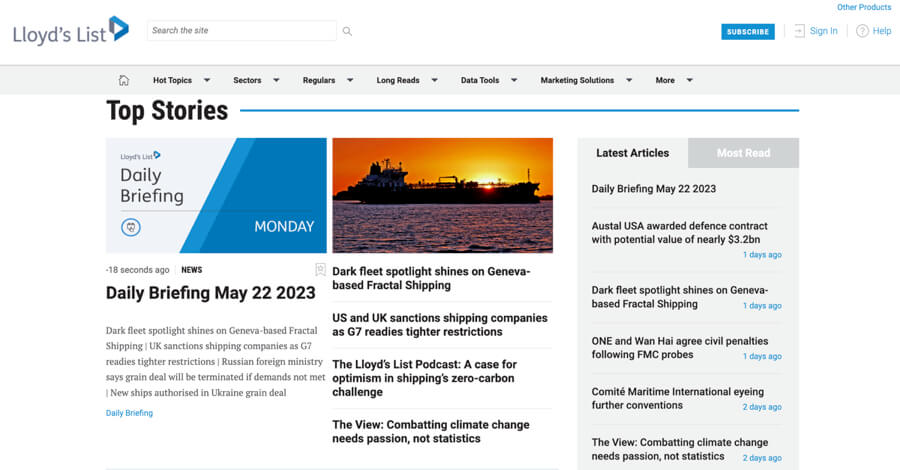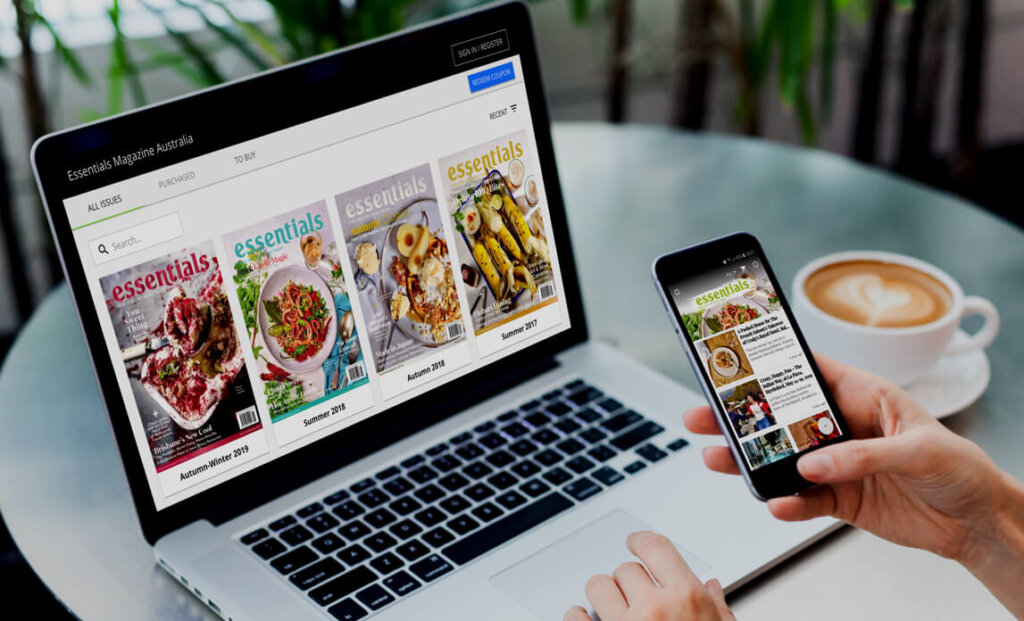Stop for a moment. Look carefully at people around you: bored in the crowded commute, exasperated in long queues at shops, relaxed on benches in parks on sunny days. Is anybody reading a paper publication? If so, how many people are doing it? To compare – how many are staring at their smartphones or laptops? No matter where you are, we will bet the answers and proportions between these numbers will be similar.
This is because the on-screen reading trend is global. Nowadays, we all hear about large publishing houses, newspaper and magazine corporations which rebrand their strategies, limit some parts of their print titles, and move their efforts to the Internet. It doesn’t happen without a reason. On the contrary, there are a number of arguments why converting a print magazine to a digital publication is a must-have in 2023.
In this article, you will see the most important ones.
Numbers don’t lie
What we see around us (and what we do by ourselves!) is using digital devices all the time: smartphones, tablets, and laptops. The reasons why we do that are different: to check emails, to contact others, to publish photos on social media channels (or to scroll them pointlessly), to watch a movie, but most of all, to read what we are interested in. Global news? Check. Local information? Check. Celebrity gossip? Check. Business, sport, hobby? Check.
The amount of content we can find on the Internet is unfinished. Every year we are more and more inclined to use our devices to consume them regularly, instead of buying a paper publication. All these observations have confirmation in research.
- In a survey conducted by Pew Research Center, 86% of American adults say they get their news from a smartphone, computer, or tablet as opposed to 32% who only often or sometimes turn to print publications.
- The global digital newspapers and magazines market size was valued at USD 34.24 billion in 2021 and is expected to expand at a compound annual growth rate of 4.2% from 2022 to 2028, according to research prepared by Grand View Research.
- In a report delivered by The Business Research Company, it was discovered that between 2021 and 2022, the market of digital publishing grew by 14.4% from $36.29 billion to $41.53 billion.
Who’s following these digital trends?
The great sign indicating that something’s changed irrevocably in the publishing sphere is the decision made by one of the world’s oldest newspapers, Lloyd’s List, being published permanently since its foundation in 1734 until its complete transition to digital in 2013. Their print era has been finished due to declining interest in the shipping newspaper’s traditional edition. Interestingly, they said goodbye to print completely, moving fully to digital offerings.

Richard Meade, the editor of Lloyd List, indicated that a digital-only model offers “new avenues and opportunities to innovate an up-to-the-minute service that offers in-depth news and information on every aspect of shipping as well as unrivaled market intelligence and data provision which can be tailored to suit our readers’ needs”.

It’s a similar story for The Seattle Post-Intelligencer, the largest American paper to drop its print edition and become an Internet-only entity, which was published daily in a print broadsheet format from its foundation in 1863 until it became an online-only publication in 2009. A barely year after this shift, the site had an estimated 2.8 million unique visitors and 208,000 visitors per day.
Many other titles with a yearslong printed tradition have decided to take similar steps, just to mention Newsweek and US News & World Report. But the thing is not only news publications (for which instant access to brand new information plays a key role) decide for being available only in the digital world. The various types of magazines are stepping on newspapers’ toes and going online: fragmentary or full-scale. Among many, the examples coming to our minds are Entertainment Weekly, InStyle, Teen Vogue, Computerworld, and New Musical Express.
Why have they done it? The short answer is: there are a lot of benefits for both, creators, and readers. The details are pretty interesting too.
Convert your print magazine to a digital publication
Technological development along with a new generation of readers as well as changing habits push publishers to find new business solutions to increase sales. That’s why they decide to complement their print publications with digital issues or to abandon print altogether and operate exclusively online.
What is the point of such strategies?
Saving money in the uncertain times
“The cost of publishing, especially of printing and paper, is skyrocketing and will go even higher in 2023, dramatically forcing the pace of media transition to digital from the print newspapers that still drive a great deal of income.” – says Peter Bale, a newsroom initiative lead of the International News Media Association.
Until a while ago, when we wrote about the economic advantage of digital publication, we had in mind mainly issues such as savings on warehouses, or distribution. Today, it’s also about rising more than 50% percent of newsprint prices along with growing printing costs. From the publishers’ point of view, printing, and distribution become simply uneconomical.
Getting with trends your readers have already known
We observe publishers invest in new technologies and strategies, such as data analytics, social media marketing, and subscription models. However, to stay competitive in this fast-changing market, and be part of the future, especially in terms of new technology development, they should be interested in solutions like AI (artificial intelligence) and VR (virtual reality).

Publishing elements have already appeared in virtual reality games – books usually exist as objects players must find. However, the possibilities go much further. Roblox (a global VR platform) has already offered to go to the shop and sell digital versions of commodities of brands like Gucci or Ralph Lauren. Based on this example, let’s consider if a similar route is possible for publishers or bookshops to enable people to enter virtual landscapes and read publications.
Using the power of digital publication
Print publications will never have the features digital ones offer, while digital publications already had everything that print press has been offering since the beginning. Well, maybe apart from the smell of freshly printed pages.
Digital publications offer facilities for modern readers, which they are… perfectly known from the mobile apps they use every day. For every new generation, the following features are desired in contact with publications:
- clear navigation structure and quick searching,
- engaging interactive content with video and music formats,
- easy sharing with others,
- hyperlinks allowing for a quick switch to another place,
- immediately accessibility everywhere and anytime,
- personalized push notifications and newsletters,
- taking care of a natural environment.
Being available around the world
The ability to distribute digital publication globally is perhaps the biggest advantage of online publishing. And you may say that, after all, in terms of printed magazines, worldwide distribution is also possible and it’s obviously true. It is possible, it has always been, but what about price and time? It is digital publishing that makes distribution easy, fast, and pleasant. At the click of a mouse button. Let’s be honest – in the post-pandemic times, digital and immediate access to favorite content is a must.
From your perspective, digital publishing means that you are able to reach a much wider audience on any place on Earth without spending money on expensive distribution networks, international free trade agreements, and paying a commission to a distributor. Doesn’t that sound promising?
Giving the content immortality
What usually has happened to the print publication after it’s already been read? It ends up in the trash, it’s used as floor protection during painting, or in the best-case scenario it’s passed along to someone else (however, in the end, it comes back to the beginning – in the trash).
Digital content will be available forever (until you delete it on purpose). Of course, news and trend texts lose their relevance quite quickly, but a significant part of your archive articles have a chance to become evergreen content and it’s a goldmine for every publisher:
- it continually drives traffic to your site,
- it ensures long live interaction,
- it provides a constant dialogue between you and your readers,
- it drives prospects to your sales funnels,
- it positions your brand as an industry leader.
Reaching customers thanks to the way of reading they love
Speaking about digital publications, we often simplify the matter by understanding it as creating content that is accessible on different Internet pages. It’s time to sort things out a bit and sum up the possibilities that stand behind it.
Let’s see two of PressPad’s products – both of them are digital publishing solutions.
- Online store with PDF-based embeddable flipbooks
Simply speaking, this kind of digital publication looks like a normal magazine but instead of being printed on paper, it’s displayed on a computer screen, with the option of flipping pages giving the feeling (and the sound!) of reading a print newspaper. The store lets people access and read the publication or PDF documents directly in the browser and can be published on the website you have already owned.

- Mobile app which allows reading your content on smartphones
No more and no less than a magazine in a mobile app version. What does the process of its preparation look like?
1. You deliver your existing PDF files without rebuilding them.
2. We prepare your own mobile app.
3. Your readers can download it from the app stores you chose: Apple App Store, Google Play, and Amazon Kindle Fire.
If you have any questions about these two solutions, don’t hesitate to ask us.
Analyzing to prepare the best offer
The key to running a publishing business successfully is to know your readers, their preferences, and their behaviors. In this aspect, online editions are absolutely unbeatable. While publishing a print magazine, you’ll never know how deep readers go into each article, how much time they spend on it, which one they chose to read, and what they want to see in future issues.
Access to in-depth analysis while digital publishing is a game-changer in the process of planning the publishing calendar, preparing marketing actions, adjusting content to the audience, and, what’s following, developing the brand. The truth is, you can measure practically everything: how many people viewed the content, how many clicked on something, what action they took after reading, and how long they spent engaging with your title.
Is it worth running a digital publication?
We can’t pretend we don’t see that print publications are existing and in some circles are doing quite well still. We are not supporters of drastic predictions that print will die someday. We also don’t like slogans saying that all publishers should go digital here and now. It’s not true.
The truth is that converting a print magazine to a digital publication is always a process. It’s not enough to say: we’re done with print. It doesn’t work like that. The decision about the beginning of this long-term process should be a result of a deep analysis of your local market situation combined with your readers’ needs. There’s no place for guessing.
Many brands started by diversifying distribution and adding to their print copies digital materials. Simultaneously, they analyze this process and ask one question: is it worth trying? For the vast majority, the answer is yes.
We can assure you that with our help the answer will always be “yes”.

